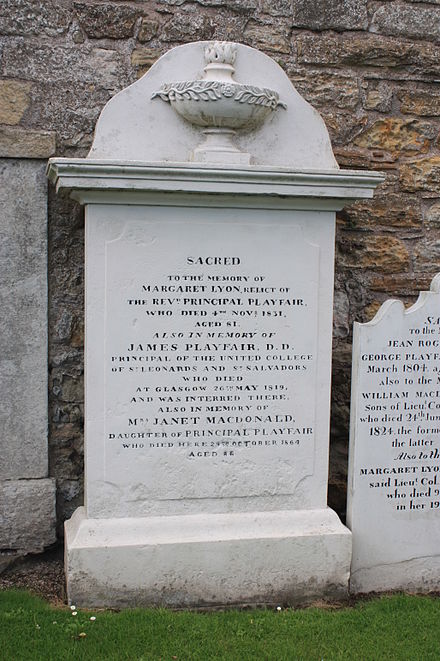This is the second guest blog post from the independent researcher John Moore, who is writing to commemorate the 200th anniversary of the death of a number of contributors to the Old Statistical Account. This time, he is focusing on the Reverend Doctor James Octavius Playfair.
________________________________
On 26th May 1819, the Reverend Doctor James Octavius Playfair, minister of the Perthshire charge of Meigle (1777-1800), died and we commemorate the bi-centenary of his death this month. Playfair was the author of the entries for both Meigle, a parish lying in the centre of Strathmore (OSA, Vol. I, 1791, p. 503-518) and the adjacent Angus parish of Eassie and Nevay (OSA, Vol. XVI, 1795, p. 212-221) in the Statistical Account.
Born the son of a farmer at West Bendochy in Perthshire, he studied at St. Andrew’s University before becoming minister of Newtyle in 1770, having been presented by James Stuart Mackenzie, Lord Privy Seal. In 1773 he married Margaret Lyon, daughter of the Reverend George Lyon of Longforgan. Seven years later, he transferred to the neighbouring parish of Meigle. During his time there, he wrote A System of Chronology in 1782, his alma mater awarded him an honorary doctorate in divinity (DD) in 1779 and in 1787 he was elected a Fellow of the Royal Society of Edinburgh.
The Meigle description appears in the first volume of the Old Statistical Account (1791) and much of the text reflects Playfair’s interests. He notes the heights of several local hills with great accuracy as ascertained by barometrical measurement and describes carefully the course of the river Isla. However, his discussion of local antiquaries, Playfair is quite scornful of early writings, stating that ‘the tales and stories related by fabulous writers are, for the most part, too wild and extravagant to merit belief’ (OSA, Vol. I, 1791, p. 505). In describing a monument in Meigle churchyard said to be dedicated to Vanora (or Guinevar), he comments that ‘the antiquary may amuse himself with the fragments that remain; but he can scarcely form one plausible conjecture with respect to their original meaning and design’ (OSA, Vol. I, 1791, p. 507).

The memorial to Rev James Playfair, St Andrews Cathedral churchyard
By 1791 the parish had a population of 1148 but the description of Meigle as an ancient, inconsiderable and meanly built town suggests that Playfair had little love for his charge, particularly as he scarcely mentions the conditions of its people. There can be no doubt, however, about where Playfair’s loyalties lay. He praises the period since 1745 as a fortunate epoch for Scotland, contrasting the formal rude and uncivilised state of the country with the benefits enjoyed following the introduction of many agricultural improvements, including his own use of a better quality of oats. The production of linen was the parish’s principal manufacture and Playfair details how progress would result from the construction of a canal between Perth and Forfar.
The account of Eassie and Nevay did not appear until four years later. Local rivers are again detailed and Playfair makes mention of James Mackenzie as its chief proprietor. Most of the text discusses various aspects of agricultural change – farms, inclosure, manures and livestock. With a population of 630, the parish inhabitants are described as ‘sober and industrious, strangers alike to intemperance and dissipation of every kind’.
At the end of 1799, he was appointed to be principal of the United Colleges of St. Leonard’s and St. Salvator’s in St. Andrew’s and moved to become minister of the congregation of St. Leonard’s in that city. It was during his time there that Playfair came into his own as a writer on geography. He published a sizeable System of Geography, Ancient and Modern between 1810 and 1814, followed by a four-volume General Atlas, Ancient and Modern (1814) and a Geographical and Statistical Description of Scotland in 1819. This final work is almost entirely based on the original Statistical Account of Scotland. In addition, Playfair was the official historiographer of the then Prince of Wales. He admired the work of Robert Burns and was one of the defenders of the authenticity of Ossian’s poems.
________________________
We would like to thank John for this guest post.